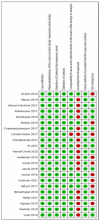Hormonal Contraception and the Risk of Breast Cancer in Women of Reproductive Age: A Meta-Analysis
- PMID: 38067328
- PMCID: PMC10705112
- DOI: 10.3390/cancers15235624
Hormonal Contraception and the Risk of Breast Cancer in Women of Reproductive Age: A Meta-Analysis
Abstract
This study aims to summarize evidence from observational studies about the lifetime use of HC and the risk of BC in women of reproductive age. The PubMed, Cochrane, and EMBASE databases were searched for observational studies published from 2015 to February 2022. Meta-analyses were performed using adjusted odds ratios and relative risks with a random-effects model using the I2 statistic to quantify the heterogeneity among studies. Of the 724 studies identified, 650 were screened for title/abstract selection, 60 were selected for full-text revision, and 22 were included in the meta-analysis. Of these, 19 were case-control studies and 3 were cohort studies. The results of the meta-analysis indicate a significantly higher risk of developing BC in ever users of HC (pooled OR = 1.33; 95% CI = 1.19 to 1.49). This effect is larger in the subgroups of case-control studies (pooled OR = 1.44, 95% CI = 1.21 to 1.70) and in the subgroup of studies that strictly define menopausal status (pooled OR = 1.48; 95% CI, 1.10 to 2.00). Although our meta-analysis of observational studies (cohort and case-control) suggests a significantly increased overall risk of BC in users or ever-users of modern hormonal contraceptives, the high heterogeneity among studies (>70%) related to differences in study design, measurement of variables, confounders, among other factors, as well as publication biases should be considered when interpreting our results.
Keywords: breast cancer; hormonal contraception; meta-analysis; premenopausal; risk factors.
Conflict of interest statement
The authors declare that they have no known competing financial interest or personal relationships that could appear to influence the work reported in this paper.
Figures







References
-
- Kanadys W., Barańska A., Malm M., Błaszczuk A., Polz-Dacewicz M., Janiszewska M., Jędrych M. Use of Oral Contraceptives as a Potential Risk Factor for Breast Cancer: A Systematic Review and Meta-Analysis of Case-Control Studies Up to 2010. Int. J. Environ. Res. Public Health. 2021;18:4638. doi: 10.3390/ijerph18094638. - DOI - PMC - PubMed
-
- Knutson T.P., Truong T.H., Ma S., Brady N.J., Sullivan M.E., Raj G., Schwertfeger K.L., Lange C.A. Posttranslationally Modified Progesterone Receptors Direct Ligand-Specific Expression of Breast Cancer Stem Cell-Associated Gene Programs. J. Hematol. Oncol. 2017;10:89. doi: 10.1186/s13045-017-0462-7. - DOI - PMC - PubMed
-
- Horseman N.D., Zhao W., Montecino-Rodriguez E., Tanaka M., Nakashima K., Engle S.J., Smith F., Markoff E., Dorshkind K. Defective Mammopoiesis, but Normal Hematopoiesis, in Mice with a Targeted Disruption of the Prolactin Gene. EMBO J. 1997;16:6926–6935. doi: 10.1093/emboj/16.23.6926. - DOI - PMC - PubMed
Publication types
LinkOut - more resources
Full Text Sources

